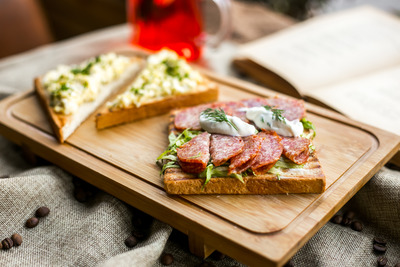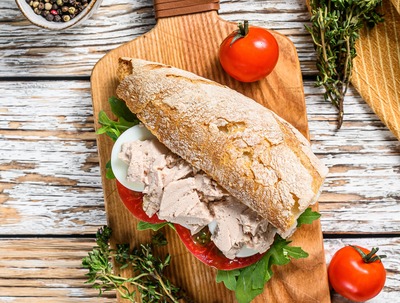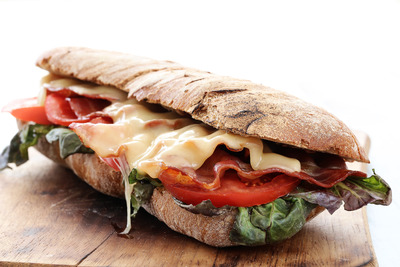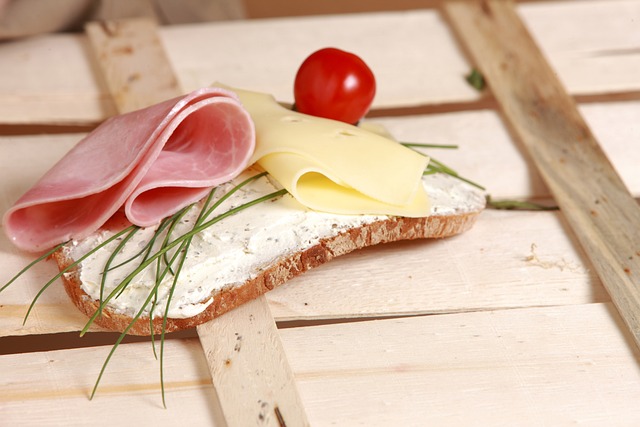France, known for its rich culinary heritage, offers a vast array of exquisite dishes, but one of the France, famous for its rich food traditions, offers many delightful dishes. One of the most beloved and simple meals is the sandwich. A typical French sandwich isn’t just a quick snack; it represents the country’s love for fresh, high-quality ingredients. French sandwiches focus on balancing flavors and showcasing the natural taste of each component.
Unlike fast-food sandwiches found in other countries, French sandwiches are part of daily life. People enjoy them during picnics, at cafés, and in bakeries. In France, sandwiches are seen as an art, where quality is always more important than quantity. Common ingredients include:
- Cured ham
- Rich cheeses
- Fresh vegetables
- The well-known French baguette
Each part contributes to creating a memorable sandwich experience.
Top Traditional French Sandwiches

France’s love for sandwiches has led to the creation of several classics. These iconic sandwiches showcase the simplicity and elegance of French cuisine.
Jambon-Beurre (Ham-Butter Sandwich)
The Jambon-Beurre is one of the most famous French sandwiches. It consists of three simple ingredients:
- A fresh, crusty baguette
- Rich butter
- Thinly sliced, cured ham
This sandwich highlights how good ingredients can elevate even the simplest dishes. The crispy baguette, creamy butter, and salty ham create a satisfying balance of flavors.
Croque-Monsieur and Croque-Madame

The Croque-Monsieur is a warm, indulgent sandwich made with:
- Ham
- Melted cheese (often Gruyère)
- Béchamel sauce
These ingredients are layered between slices of toasted bread and grilled until crispy. The Croque-Madame is a variation of the Croque-Monsieur. It includes a fried or poached egg on top, adding richness and making it a favorite brunch dish. These sandwiches are commonly enjoyed in French cafés, especially as a mid-day meal.
Pan Bagnat

Hailing from Nice, the Pan Bagnat is a Mediterranean-style sandwich packed with fresh ingredients like:
- Tuna
- Hard-boiled eggs
- Olives
- Tomatoes
- Anchovies
It’s similar to a Niçoise salad, but served inside crusty bread. A drizzle of olive oil ties the ingredients together, making this sandwich a light and refreshing option, perfect for warm weather.
Other Popular Variants
In addition to these famous options, France offers many other delicious sandwich varieties, each with its own unique twist.
Tartine (Open-Faced Sandwich)

The Tartine is an open-faced sandwich, typically served on rustic bread or a baguette. The toppings often include:
- Smoked salmon and cream cheese
- Avocado and poached egg
- Pâté with pickles
Tartines are a common choice in French cafés, where they are served as light snacks or meals. Their simplicity makes them versatile, and the fresh toppings allow for endless combinations.
Le Sandwich au Pâté

For those who enjoy hearty flavors, the Sandwich au Pâté offers a rustic and satisfying meal. It’s made with:
- A thick spread of traditional French pâté (usually pork or duck)
- Crunchy pickles
- A fresh baguette
The combination of rich pâté and tangy pickles creates a balanced flavor that’s both indulgent and delicious. This sandwich is perfect for picnics or casual outdoor meals.
Sandwich Mixte

The Sandwich Mixte is a simple but delicious version of the classic ham and cheese sandwich. It consists of:
- Ham
- Cheese (typically Emmental or Gruyère)
- A thin layer of butter
- A fresh baguette
The Sandwich Mixte can be eaten cold, but it’s often toasted to create a warm, melty option. It’s a popular choice in French bakeries and cafés for a quick and satisfying lunch.
French Baguette: The Bread Behind the Sandwich
The foundation of most French sandwiches is the bread, and in France, the baguette is a symbol of quality and tradition.
Importance of the Baguette in French Culture
In France, the baguette plays an essential role not only in sandwiches but also in everyday life. The French take great pride in their bread, and most people buy fresh baguettes daily. The perfect baguette is crucial for making a great sandwich, providing the right balance of crunch and softness.
The crispy crust and airy interior of a baguette make it ideal for sandwiches like the Jambon-Beurre or Sandwich Mixte. Whether you enjoy it on its own or with fillings, the baguette brings a unique texture that complements the flavors inside.

Characteristics of an Authentic French Baguette
To be considered an authentic French baguette, the bread must meet certain standards. The ideal baguette has:
- A thin, golden-brown crust
- A light, soft interior with irregular holes
- A subtle, slightly sweet flavor
The slow fermentation process gives the baguette its distinct taste. This texture and flavor make it the perfect choice for absorbing the juices of sandwich fillings while maintaining its structure.
In the end, the baguette is what truly sets French sandwiches apart, offering a delicious and satisfying experience in every bite.
DIY French Sandwich Recipes
French sandwiches can easily be made at home with just a few simple ingredients. Whether you want to enjoy a quick snack or recreate the flavors of France in your kitchen, these recipes will guide you through the process of making some of the most iconic French sandwiches.
How to Make Jambon-Beurre at Home
The Jambon-Beurre is a straightforward sandwich that relies on high-quality ingredients to deliver its delicious taste. Here’s how to make it at home:
Ingredients:
- 1 fresh baguette
- 2 tablespoons of unsalted, high-quality butter
- 4 to 6 slices of thinly sliced cured ham (preferably French ham)
Steps:
- Prepare the baguette: Slice the baguette lengthwise but not all the way through, so it stays connected at the back.
- Spread the butter: Generously spread the butter on both sides of the baguette.
- Add the ham: Layer the ham inside the baguette, folding it to fit evenly.
- Close and serve: Press the sandwich closed and cut it into smaller portions if desired. Serve fresh!
This simple sandwich captures the essence of French cuisine—minimal ingredients but maximum flavor.
Croque-Monsieur Recipe
The Croque-Monsieur is a rich and warm sandwich, perfect for a hearty meal. Follow this easy recipe to create a classic version at home:
Ingredients:
- 4 slices of bread (preferably pain de mie or white sandwich bread)
- 4 slices of ham
- 1 cup grated Gruyère cheese
- 2 tablespoons butter
- 1/4 cup béchamel sauce (made with butter, flour, and milk)
Steps:
- Preheat the oven: Set the oven to 400°F (200°C).
- Prepare the béchamel: Spread a thin layer of béchamel sauce on two slices of bread.
- Assemble the sandwich: Add ham and a generous handful of grated Gruyère on top of the béchamel-covered bread slices. Close the sandwiches with the other slices of bread.
- Toast and bake: Melt butter in a pan and toast the sandwiches until golden brown on both sides. Once toasted, top each sandwich with more béchamel sauce and grated cheese. Transfer to the oven and bake until the cheese is melted and bubbling.
- Serve: Cut and enjoy the crispy, cheesy goodness of this classic French sandwich.
Pan Bagnat Recipe
The Pan Bagnat is a refreshing sandwich that brings Mediterranean flavors to your plate. Here’s how to prepare it:
Ingredients:
- 1 small round loaf of bread (or any crusty bread)
- 1 can of tuna, drained
- 1 hard-boiled egg, sliced
- 1 tomato, sliced
- 1 small red onion, thinly sliced
- Olives, anchovies (optional)
- Olive oil
Steps:
- Cut the bread: Slice the round loaf in half horizontally.
- Assemble the ingredients: On the bottom half, layer the tuna, hard-boiled egg, tomato, onion, and optional olives or anchovies.
- Drizzle with olive oil: Generously drizzle olive oil over the ingredients.
- Close and press: Place the top half of the loaf on the sandwich and press down firmly. Wrap the sandwich tightly in plastic wrap and refrigerate for an hour to let the flavors meld.
- Serve: Slice and serve chilled.
Why French Sandwiches Stand Out in Global Cuisine
French sandwiches are unique not only for their delicious taste but also for their cultural significance. Here’s what sets them apart:
The Art of French Culinary Simplicity
French sandwiches embrace the idea that less is more. With just a few well-chosen ingredients, these sandwiches offer a rich, satisfying experience. Whether it’s the buttery perfection of a Jambon-Beurre or the indulgent layers of a Croque-Monsieur, French sandwiches highlight the natural flavors of each component without overwhelming the palate.
French Sandwiches and French Café Culture
Eating a sandwich in France is often about more than just satisfying hunger—it’s an experience. Whether you’re sitting at a bustling café in Paris or enjoying a quiet meal in the countryside, sandwiches are part of daily life in France. They represent the casual, yet sophisticated, side of French dining, where quality and enjoyment go hand in hand.
Summary Table: Tips and Notes
| Sandwich Type | Key Ingredients | Cooking Tips | Cultural Note |
|---|---|---|---|
| Jambon-Beurre | Baguette, butter, ham | Use the freshest baguette and highest quality butter available for the best flavor. | Popular in bakeries and cafés across France. |
| Croque-Monsieur | Bread, ham, Gruyère, béchamel sauce | Toast the sandwich in a pan before baking to achieve a crispy texture. | Often served in French cafés, especially for brunch. |
| Pan Bagnat | Tuna, hard-boiled eggs, vegetables, oil | Wrap the sandwich tightly and refrigerate for an hour to allow the flavors to develop. | Originates from the Nice region, known for Mediterranean flavors. |
| Croque-Madame | Same as Croque-Monsieur + fried egg | Fry or poach the egg just before serving for maximum freshness. | Adds extra richness with the egg on top. |
| Sandwich Mixte | Baguette, ham, cheese, butter | Toast the sandwich for a warm version or enjoy cold for a quick meal. | Simple, everyday sandwich found in many French bakeries. |
Frequently Asked Questions (FAQs)
Here are some common questions about French sandwiches, which might help you better understand these classic dishes.
What is the most popular sandwich in France?
The Jambon-Beurre is widely considered the most popular sandwich in France. Its simplicity and reliance on just a few high-quality ingredients make it a national favorite, sold in bakeries and cafés across the country.
What type of bread is used for French sandwiches?
The baguette is the most common bread used for French sandwiches, thanks to its crispy crust and soft interior. However, other types of bread like pain de mie (soft sandwich bread) or round crusty loaves are also used for different sandwiches, such as the Pan Bagnat.
How is a Croque-Madame different from a Croque-Monsieur?
A Croque-Madame is similar to a Croque-Monsieur but with one key difference: it includes a fried or poached egg on top. The egg adds an extra layer of richness and makes it a more filling option.
Can I make a French sandwich with gluten-free bread?
Yes, you can make a French sandwich with gluten-free bread. Many bakeries and grocery stores offer gluten-free baguettes and sandwich breads, so you can enjoy classics like the Jambon-Beurre or Croque-Monsieur with a gluten-free alternative.

